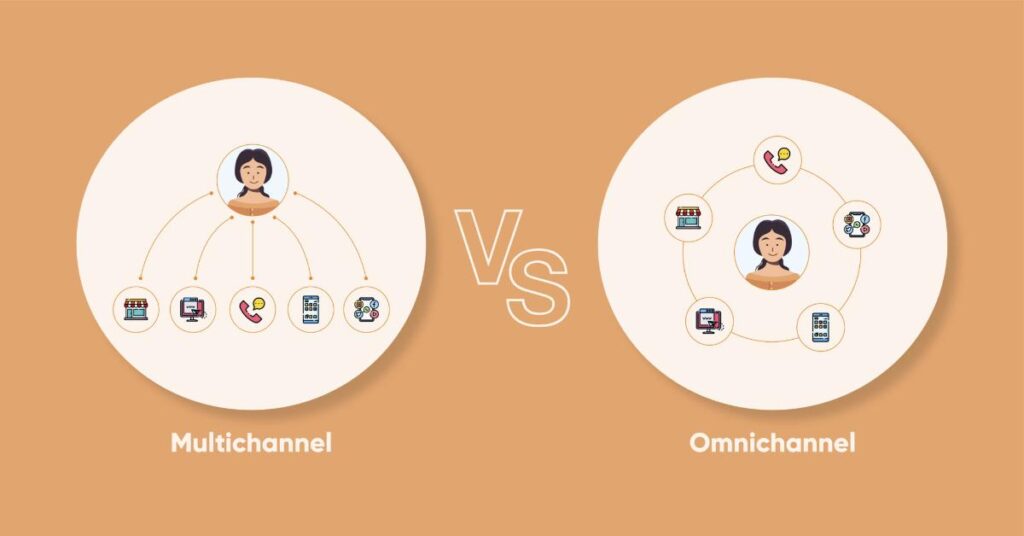Consumers today have more options than ever when it comes to the channels they interact with in their buying journey. And this is great! But for businesses, this means extra work to make sure their customer experience is consistent across all touch points. This has led to the rise of two marketing strategies: multichannel and omnichannel.
While both approaches involve the company’s presence on multiple channels to reach its customers, there are some subtle (but significant) differences between the two.
So let’s explore these differences and understand which option is best suited for your business.
Multichannel vs Omnichannel: What Are They?
Most likely you have heard the terms multichannel and omnichannel thrown around in a conversation or marketing materials. And even worse, you might heard people using them interchangeably. While they might sound similar, they represent different approaches to teaching and engaging with customers.
Multichannel marketing consists of using multiple channels to reach your target audience, such as a website, a physical store, email, and social media. But each channel is operating as a standalone part of the customer experience. Think of a hardware store that has brick-and-mortar stores and a website. While customers can use both options to buy their products, the experience is totally different.
Omnichannel marketing, on the other hand, creates a unified customer experience across all channels. The focus is not on the product anymore – but on the customer. You make sure that they have a consistent buying journey regardless of how they interact with your brand. For example, a customer might research a product online, add it to their cart, buy it, and choose the in-store pick-up option. Or they might even decide to purchase it in-store while benefiting from in-person assistance.
The TL;DR would be that multichannel marketing is about making your products available on different platforms/channels. While omnichannel marketing is about providing a cohesive customer experience.

The Main Differences Between Multichannel vs Omnichannel
Now that we know what each approach is about in the general sense, let’s talk more about the most important differences between the two.
| Feature | Multichannel | Omnichannel |
| Focus | Product availability | Customer experience |
| Customer journey | Fragmented experience | Unified and seamless journey |
| Customer data | Siloed data | Centralized and integrated data |
| Technology | Basic channel management | Advanced integration and analytics |
Focus
- Multichannel: the primary focus of multichannel marketing is product availability across all the platforms/channels you are present on. You want to make sure that your products are available to the users wherever they might be shopping: physical stores, websites, mobile apps, and catalogs. The emphasis here is on reach and distribution.
- Omnichannel: with the omnichannel approach you want to give your customers a unified experience across all touch points. Your messaging and brand experience should be consistent regardless of where your customers interact with your business. This will ensure that they have a smooth transition between the channels.
Customer journey
- Multichannel: the customer journey is fragmented and specific to each channel. It is like having completely different funnels for each of the platforms the customers are using.
- Omnichannel: this approach strives to create a cohesive and interconnected customer journey. The visitors can switch devices or platforms without perceiving any disruption in the experience or any inconsistencies.
Customer data
- Multichannel: the data is often kept at a platform/channel level. This siloed way of looking at it makes it challenging to have a complete understanding of consumer behavior. Marketing and sales might have limited visibility of the historical data which makes it hard to personalize interactions and offers.
- Omnichannel: the data is centralized, shared, and integrated in all the channels. At any point in time, across all platforms, the company understands the user’s journey, behavior, and historical actions done by that user.
Technology
- Multichannel: requires basic technology to set up and manage individual channels separately. Companies may use different systems for managing their website, email marketing, and paid advertising channels.
- Omnichannel: requires a much more advanced and complex technology to integrate multiple channels, manage customer data, and have an overall solid consistency. You would need to use customer relationship management (CRM) systems, marketing automation platforms, and advanced analytics tools to support your efforts.
Implementation
- Multichannel: simple implementation since a channel is viewed as a separate customer journey path. Adding new channels just requires basic tools which, most likely, are already in use for other channels.
- Omnichannel: the complexity level is high because all the channels are viewed as part of one big system. Adding a new channel will require careful consideration and analysis to make sure it integrates well with the existing ones and that the user doesn’t perceive it as out of place.
Measuring the Success of Your Omnichannel Strategy
No marketing effort is complete without tracking your results and measuring the success of your campaigns. So let’s have a look at what you can measure to assess the results of your omnichannel strategy.
Key Performance Indicators (KPIs)
Customer Satisfaction: Measure customer satisfaction across all channels through surveys, feedback forms, or reviews. You can use a Net Promoter Score (NPS) measurement and see if you have any weak points in your approach.
Customer lifetime value (CLTV): Track the total revenue a customer generates over time. The higher the number, the stronger the relationship you have built with them.
Conversion rates: Analyze the conversion rates throughout the customer journey and always look for areas of improvement.
Customer acquisition cost (CAC): Calculate the cost of acquiring a new customer through each channel. You might find that some of your channels are bringing in a lot of cold traffic while some others might be better suited to re-engage with existing customers.
Marketing efficiency ratio (MER): Measure the impact of your marketing efforts on the overall business. This is a better metric to base your decisions on whether to add or drop channels/platforms from your marketing mix.
Tracking the Customer Journey
By analyzing consumer behavior and how people are interacting with your business across all channels, you will identify drop-off points or areas where you can double down. Use tools like Google Analytics or CRM systems to gather data on customer interactions, touchpoints, and conversions. This will allow you to make informed decisions about each channel and how you allocate resources.
Attribution modeling
This is a hot topic in the marketing world because there is no way of tracking user behavior 100% accurately. But this doesn’t mean you should not try your best to get the most complete attribution model. This will allow you to identify trends and patterns in your data which will open up a lot of opportunities to increase your business and offer a better customer experience.
A/B testing
It is important to continuously test new ideas and tweak different elements in your omnichannel strategy. Even if the idea is an industry standard or if it worked for other businesses (e.g. competitors) you can’t be sure that something works until you test it for yourself. This can be anything from new channels, different messaging, visuals, placements, calls to action (CTAs), etc. If you form this habit, the results of your successful experiments will compound over time leading to exponential growth.



